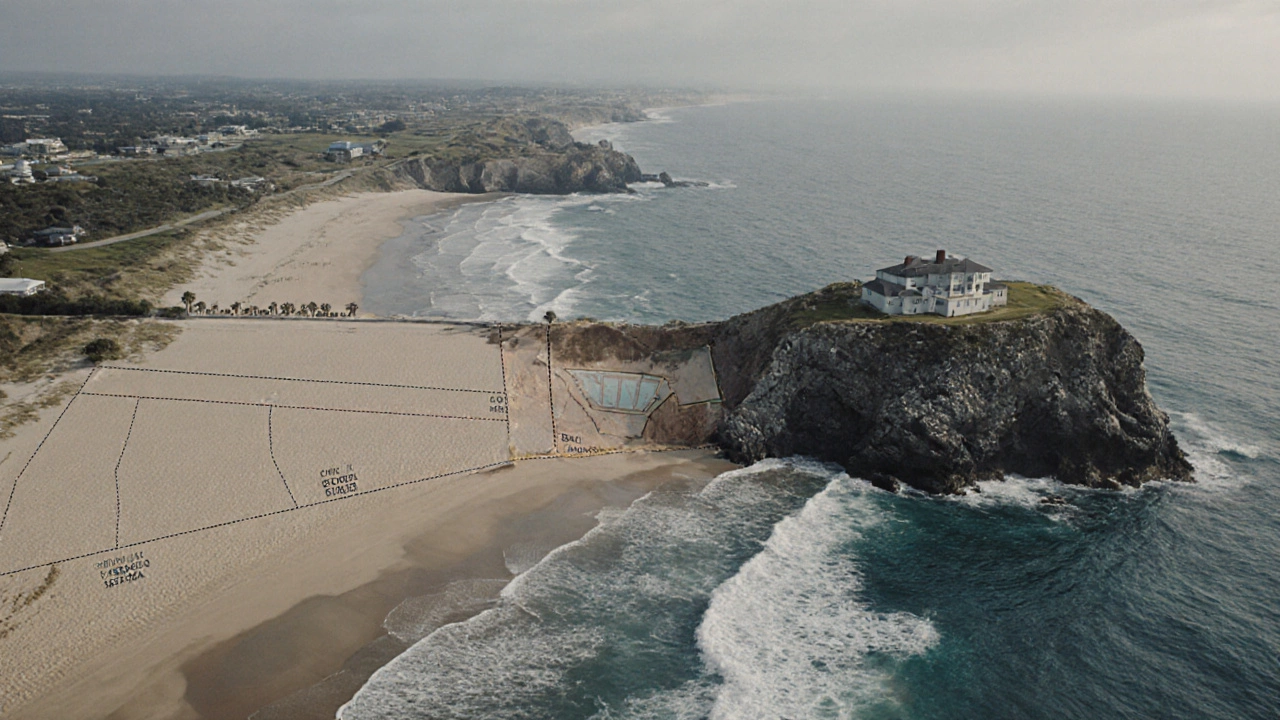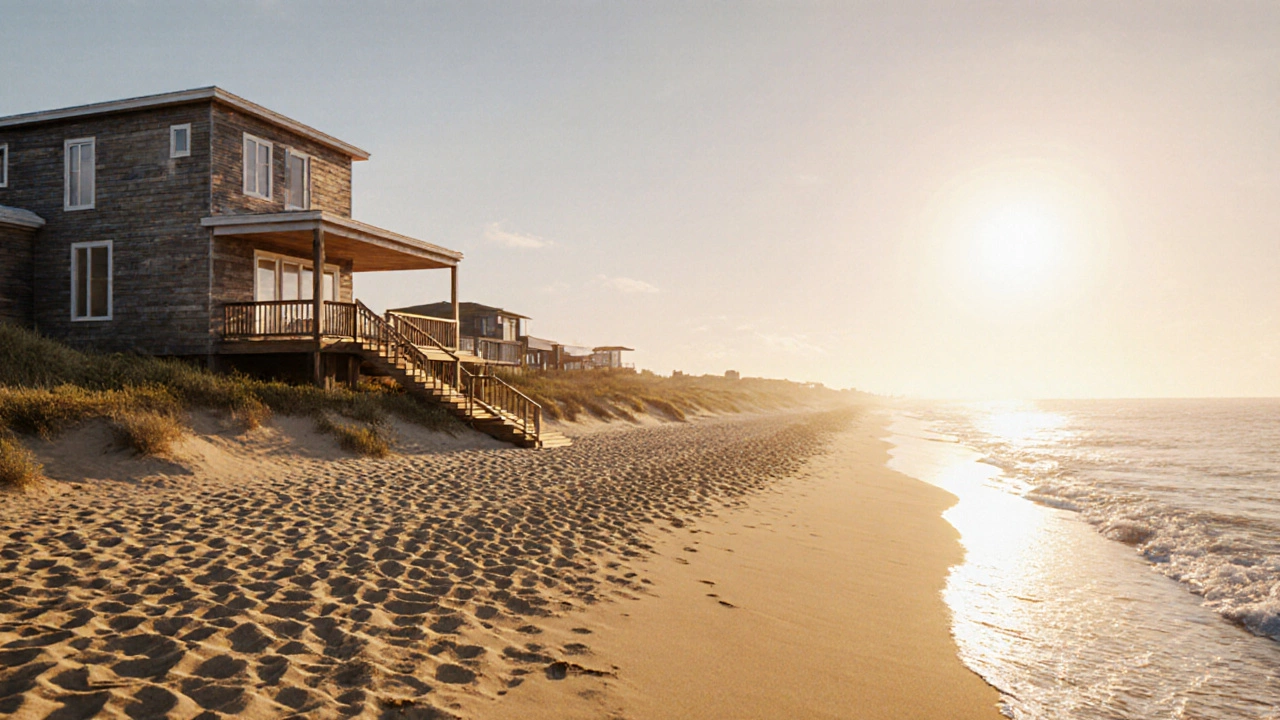Beachfront vs Oceanfront Property Calculator
Your Priorities
Results
Beachfront Property
Score: 0/100
Best for: Direct beach access, daily sand activities, premium rental income
Oceanfront Property
Score: 0/100
Best for: Panoramic views, lower flood risk, steady appreciation
Trying to decide between a beachfront property and an oceanfront property can feel like a guessing game, especially when listings use the terms interchangeably. The truth is, each label carries distinct legal, financial, and lifestyle implications that can affect everything from your daily routine to long‑term resale value. This guide breaks down the core differences, walks you through the factors you should weigh, and gives you a handy comparison table so you can pick the right spot for your next investment or vacation home.
What exactly is a beachfront property?
When you see a listing that says Beachfront Property is a type of real estate that directly borders a sandy beach, offering immediate foot‑traffic to the shoreline and usually a private or semi‑private sand access area. In most jurisdictions, the legal definition hinges on the presence of a strip of public beach land between the property line and the water. That strip may be owned by the municipality, but the homeowner enjoys direct, unobstructed views and the convenience of stepping straight onto the sand.
And what about an oceanfront property?
An Oceanfront Property is defined as any land or building that faces the open ocean, regardless of whether a beach lies in front of it. It could sit on a cliff, a rocky bluff, or a man‑made promenade. The key distinction is the presence of a beach - oceanfront owners may have a breathtaking view of the sea but often lack direct beach access without crossing public land or private paths.
Legal and zoning nuances
The legal framework for beachfront versus oceanfront varies by country and even by county. Zoning Regulations govern what you can build, how close structures can be to the waterline, and which utilities are required. In coastal states like California, beachfront parcels are subject to stricter setback rules to protect public beach rights, whereas oceanfront cliffs may have different erosion allowances. Always check the local land‑use code before signing a contract; a mislabeled property can lead to unexpected restrictions on adding decks, pools, or even raising the building.
Price premiums and market dynamics
Data from the National Association of Realtors (2024) shows that beachfront homes command an average premium of 31 % over comparable oceanfront properties. The premium reflects the higher demand for private beach access, limited inventory, and the perceived exclusivity of owning a spot where you can literally walk out onto sand. However, this premium narrows in markets where oceanfront cliffs are highly coveted for their dramatic vistas, such as the Big Sur region, where oceanfront can sometimes out‑price beachfront due to scarcity.

Environmental factors: erosion, flood risk, and climate change
Coastal erosion is a major concern for both types, but the risk profile differs. Coastal Erosion refers to the natural wearing away of shorelines due to wave action, storms, and rising sea levels tends to bite harder at low‑lying beachfront strips, which can recede several feet per year in high‑impact zones like the Gulf Coast. Oceanfront cliff owners face rockfall and landslide hazards, especially in areas with unstable geology.
Flood Risk measures the likelihood of water intrusion from storm surge, tide spikes, or seasonal high waters is generally higher for beachfront properties because they sit at or below the high‑tide line. Insurance premiums for beachfront homes can be 2‑3 times higher than for oceanfront homes situated on elevated terrain. Investing in resilient construction-elevated foundations, flood‑grade materials, and proper drainage-can mitigate some of these costs.
Lifestyle and amenity considerations
From a lifestyle standpoint, beachfront properties excel in convenience. You can set up a sunrise yoga session on the sand, host a beach barbecue, or simply let kids play just steps from the water. Oceanfront homes often provide spectacular panoramic views, which are perfect for photographers, painters, and anyone who values scenic seascapes without the sand underfoot.
When it comes to amenities, beachfront communities frequently include private beach clubs, direct surf‑board rentals, and on‑site lifeguard services. Oceanfront resorts may offer cliff‑side infinity pools, rooftop terraces, and easier parking because they are not constrained by beachfront access roads.
Investment outlook: resale value and rental potential
Property Valuation takes into account location, view, access, and risk factors to estimate market worth for beachfront homes is typically more volatile. During boom years, prices surge due to high demand, but during recession or after severe storm damage, values can dip sharply. Oceanfront properties, while often less pricey, tend to hold value more consistently because they are less exposed to beach erosion and can appeal to a broader buyer pool seeking scenic views without the higher maintenance costs.
Rental income is another angle: beachfront vacation rentals usually fetch higher nightly rates-sometimes 25 % more-thanks to the premium guests place on immediate beach access. However, they also attract stricter local short‑term rental ordinances, which can limit occupancy days. Oceanfront rentals may have lower rates but enjoy more flexible policies and a larger market of travelers who prefer scenic stays over sand‑centric experiences.

How to choose the right option for you
- Define your priority: Is direct beach access a non‑negotiable, or do you value panoramic ocean views more?
- Assess risk tolerance: Consider flood insurance costs, erosion forecasts, and maintenance budgets.
- Check local regulations: Verify setback rules, building permits, and short‑term rental limits.
- Run the numbers: Compare purchase price, insurance, property taxes, and expected rental income.
- Visit the site: Walk the property at different tide levels to see how the beach line shifts and gauge the view quality.
Side‑by‑side comparison
| Attribute | Beachfront Property | Oceanfront Property |
|---|---|---|
| Typical View | Unobstructed sand and water line | Wide ocean vista, may include cliffs or rocks |
| Direct Access | Yes - step straight onto beach | Often no - access via public pathways or roads |
| Average Price Premium | ~31 % above comparable oceanfront | Baseline market price |
| Flood Risk | High - may require flood insurance | Lower - elevation reduces surge impact |
| Erosion Threat | Higher - beach retreat can eat land | Variable - rock cliffs may be stable or prone to landslides |
| Rental Income Potential | Higher nightly rates, stricter regulations | Moderate rates, more flexible rules |
| Typical Amenities | Private beach clubs, surf rentals, lifeguard services | Infinity pools, rooftop decks, scenic walkways |
Quick FAQ
Can a beachfront property lose its beach over time?
Yes. Natural processes like erosion, storms, and sea‑level rise can move the shoreline inland, potentially reducing the usable beach area. Regular shoreline surveys help owners understand the rate of change.
Do I need flood insurance for an oceanfront home?
While oceanfront homes generally sit higher than the high‑tide line, they can still be vulnerable to storm surge. Many insurers require flood coverage for any coastal property within a designated flood zone.
Which type typically offers better resale value?
Beachfront homes often sell for more when the market is hot, but their value can fluctuate with erosion and insurance costs. Oceanfront properties tend to have steadier appreciation because they face fewer physical risks.
Are there tax advantages specific to beachfront ownership?
Some jurisdictions offer reduced property tax rates for historic beachfront districts or for properties that contribute to tourism revenue. Check local tax codes for any coastal‑property incentives.
How does maintenance differ between the two?
Beachfront homes require more frequent salt‑air corrosion mitigation-think stainless steel fixtures, regular painting, and premium roofing. Oceanfront homes face rock‑fall clearance and may need reinforced foundations on cliffs.
In the end, the decision comes down to what you value most: the luxury of stepping onto sand at sunrise or the drama of an endless ocean horizon from a high perch. By weighing legal constraints, cost implications, environmental risks, and lifestyle perks, you can choose the coastal property that fits both your heart and your wallet.
